Winter brings many beautiful flowers into bloom. Flowers provide a much-needed brightness boost during the gloomiest days of the year, whether planted in beds or containers. It is also important to consider placement when choosing the best winter flowers.
If you want to enjoy them from inside your house, plant them somewhere, you can see them when they bloom. Since they are so unexpected, they also make a great addition to curb appeal during winter. It is also essential to plant your winter flowers in the fall, a few weeks before the ground freezes, so they can get established before the winter begins.
Top 25 flowering plants that bloom in winter
Calendula
Any garden can benefit from calendula. It is often grown with vegetables because it benefits the soil, deters pests, and is edible. In addition to being commonly grown in containers, calendula is also known as “pot marigold.” Calendula can also be grown directly in the garden as an ornamental plant, a pest-deterring companion plant, or a medicinal herb. Despite some varieties being short-lived perennials in zones 8 to 10, most gardeners grow calendula as annuals. When grown as an annual, calendula does not need winter care.
In case you missed it: Earning 70 Lakhs from Rose Cultivation in 5 Acre Polyhouse: The Success Story of a Flower Farmer
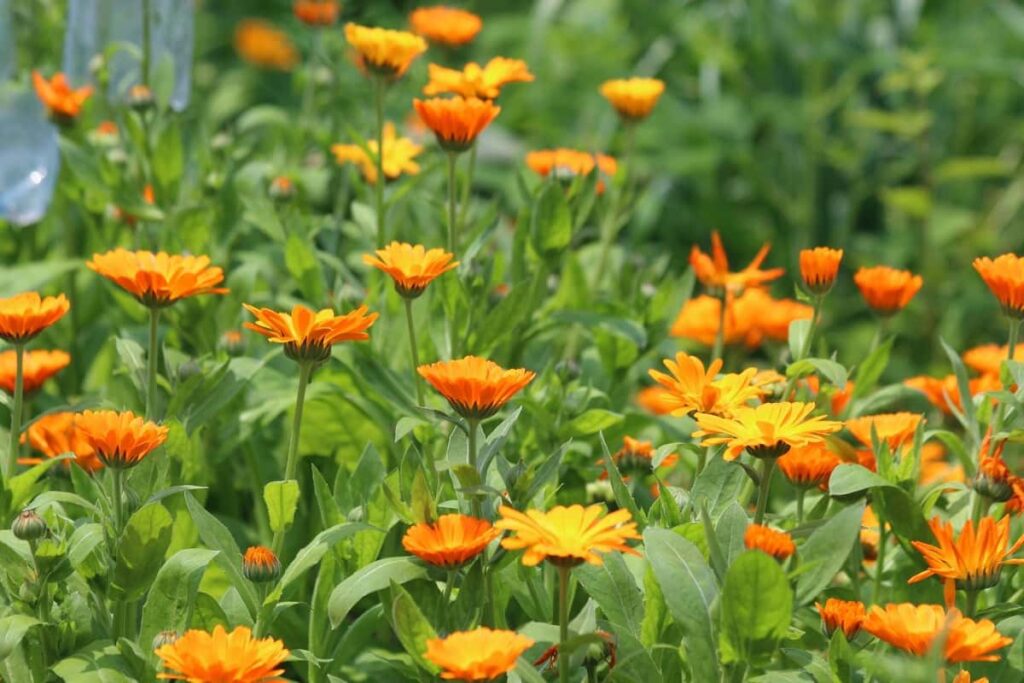
Petunia
Because of their exceptional blooms and long flowering period, petunias are among the most popular flowers. In most areas, petunias are treated as annuals, but in Zones 9-11, they can be grown as tender perennials. The flowers bloom from spring until frost and come in many colors and patterns. Colorful annuals are often used in borders, containers, hanging baskets, or as seasonal groundcovers for front lawns. It is even possible to find some with a slight fragrance. They can range in height from 6 to 18 inches and spread from 18 inches to 4 feet.
Pansy
Even beginner gardeners will recognize that spring has arrived when they see a long bench of pansies at the garden center. After a long winter, these plants bring color and cheer to the landscape, and if you live in a warm region, they can also add a punch of autumnal color to fading autumn gardens. From September to April or May, pansies can provide colorful blooms for much of that time if planted in the autumn. They usually aren’t very pretty in winter, but their spring blooms can be even more impressive when they’ve been planted since fall.
Allysum
An alyssum is a delicate carpet of tiny flowers with a sweet fragrance. During much of the growing season, flowers cover the low-growing foliage. Lobularia is very easy to grow from plants or seeds. Alyssum is a cool-season flower that can be set out in early spring and grown in frost-free climates throughout the fall and winter. Sweet Alyssum is a fast bloomer and is one of the best attractors of beneficial insects and butterflies.
In case you missed it: How to Control Pests and Diseases in Flower Crops: Causes, Symptoms, Chemical, and Biological Management
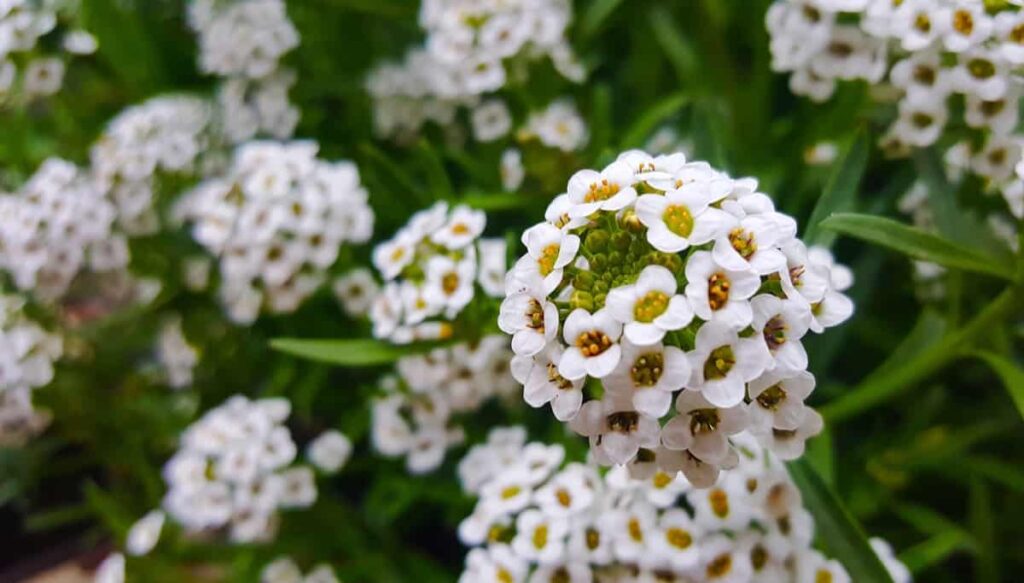
Snapdragons
The Snapdragon plants are short-lived perennials usually grown as annual plants in gardens. They are a mainstay of classic flower gardens, from mixed border gardens to flower boxes to patio containers. The bright snapdragon flowers bloom profusely in intensely saturated colors throughout cold weather, making them a real show-stopper in the spring or fall garden.
During the long blooming period, the flowers bloom at the bottom of the stalk and work their way up. Even though snapdragons slow down and stop blooming in the mid-summer heat, if you keep them watered, they will revive and carry your garden into fall.
Aster
When grown and cared for properly, asters add a splash of color to autumn landscapes while providing beauty with little effort. Despite this, there are many species and about 200 cultivars, with plant heights ranging from a few inches to 12 feet. In addition to blue and pink, asters can also be purple, red, white, and yellow. Some species and cultivars bloom during other times of the year, but most bloom in the fall. Winter blooms are even found on some asters. Your garden can have asters blooming year-round with careful selection.
Carnation
Dianthus caryophyllus, also known as carnations, is a bright flower with two layers of silky petals that come in many colors. Their long, sturdy stems make them popular cut flowers. In addition to Snowdrops, they are the birth flower for January. Spring or autumn is the best suitable to plant carnations when the weather is not too hot or cold. If the mood strikes you in winter, you can also start sprouting carnation seeds indoors and then transfer them outside once the temperature rises.
In case you missed it: Earning 24 Lakh Rupees from Polyhouse Chrysanthemum Cultivation: A Success Story of a Flower Farmer in India
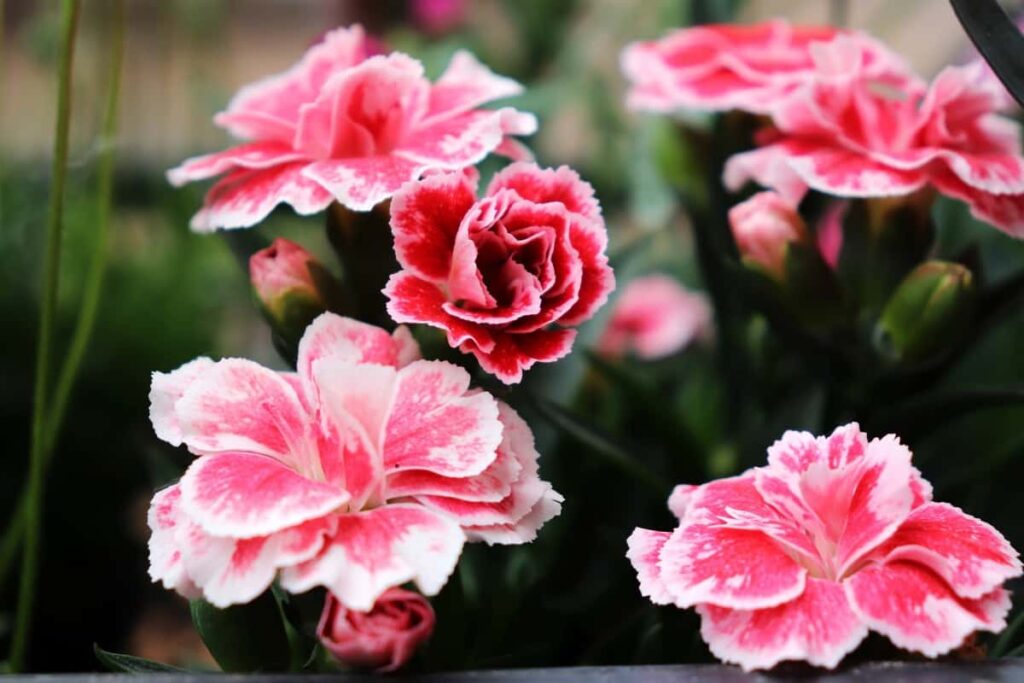
Buttercup
Persian buttercups are known for their brilliant colors, ruffled petals, long stems, and long vase life. They are popular in florist shops and wedding bouquets because of their vibrant colors, ranging from pink, red, and purple to cream, light yellow, and orange. They can survive colder temperatures, making them ideal for winter plantations. Despite being winter-hardy, they cannot withstand frost. As one of the best winter-flowering plants, these plants have vividly colored, rose-like flowers that look surreal, lighting up spaces where they are placed.
Hyacinths
Hyacinths are one of the season’s first blooms, so they look best at the front of a perennial garden, near the front door, in mixed borders, or along a walkway. These beauties are also excellent choices for pots and planters. Hyacinths look stunning in bouquets, too, and make wonderful cutting flowers.
Various shades of these bell-shaped fragrant bulbs need cold temperatures and full sun to grow. Furthermore, they do not require a larger space. Due to their compact growth, they can easily be planted in containers. Around September to October is the best time to plant bulbs. Ensure the bulbs are large, fat, and free of disease and rot.
Fuschia
Fuschias can also be grown in winter due to their preference for colder climates and well-drained soil. Fuchsias are known for their colorful, dancing, skirt-shaped, bell-shaped flowers. Thousands of flowers are available in white, candy pink, magenta, purple, and red that last all summer long.
Some varieties have golden or variegated foliage, and the leaves are purple or reddish. Fuschias can be tricky to care for, but if you do it right, you’ll see heartwarming results. It may not be able to withstand freezing temperatures. Despite this, it can survive well indoors in winter.
Verbena
In addition to being one of the coolest common flowers, verbena is also called Tears of Isis. The plant is native to the Americas and Asia but popular worldwide. These sun-loving plants can thrive in the colder climates of the Himalayan states. There are a variety of colors available, including red, purple, white, and pink. A pot can grow two to three varieties together to create an attractive garden piece. In addition to attracting hummingbirds, bees, and butterflies, verbena flowers provide a rich nectar source for pollinators.
In case you missed it: USA Soil pH Chart: Ideal and Optimum Range for Vegetables, Fruits, Flowers, and Herbs
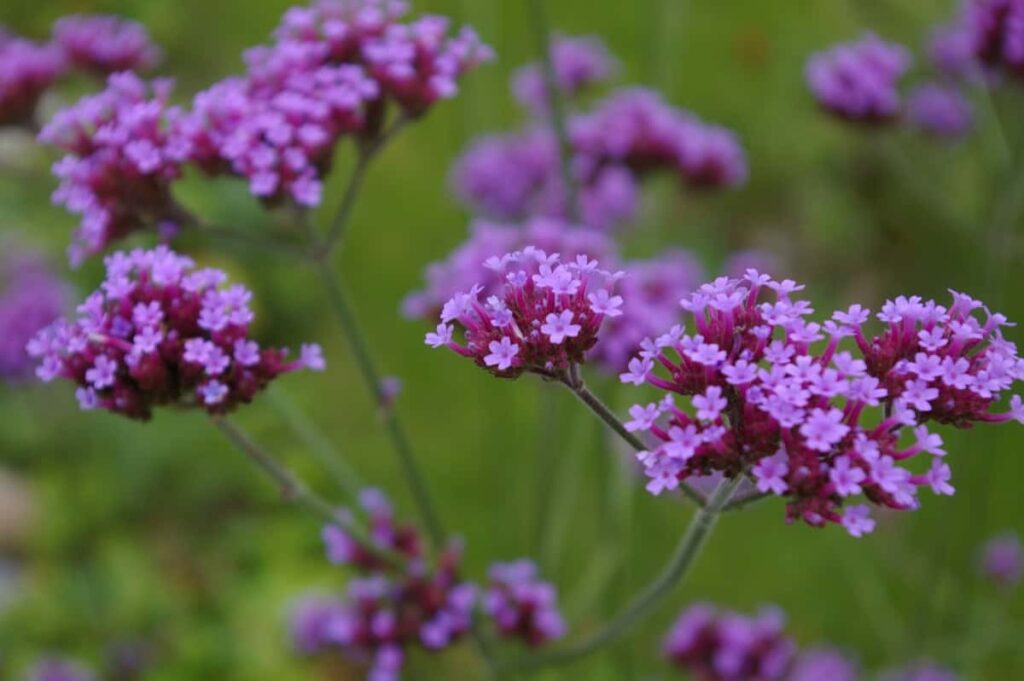
Cineraria
Cineraria flowers are known for their vibrant shades of pink, red, purple, blue, and many bi-colors, as well as their long-lasting blooms. The plant forms mounds with large leaves covered with blossoms during the blooming season. As a garden plant, Cineraria does best in cool weather, so it’s usually grown for spring blossoms and then removed to make room for summer-blooming annuals.
As container plants rather than in-ground bedding plants, they are preferred by many gardeners. Commercially grown cineraria have been grown for their cool-season spring blooming in nurseries starting in the spring.
Winter Heath
This low-growing shrub flowers in winter, making it a pleasant exception. It is a member of the heath family (Ericaceae), belonging to the heather genus (Erica). Western, central, and southern Europe and parts of Morocco are home to winter heath, which can be found anywhere from lowlands to high alpine regions. There are needle-like, rolled-up leaves on the branches of this evergreen dwarf shrub that grows to a maximum height of 30 cm. This shrub usually blooms between January and April, making it one of the earliest flowering shrubs.
Mahonia
Mahonia is also called the Oregon grape, which originated in North America. Flowers that are fragrant and golden-yellow accompany the blueish fruits (or grapes). Winter-active bees and other pollinators depend on these winter blooms for pollen and nectar. Underplanted with contrasting foliage plants that thrive in the shade, mahonias look fantastic with their evergreen spiny foliage. Late fall through early winter, this evergreen shrub has bright yellow flowers that last for weeks.
Ipheion
The Ipheion spring starflower is a small flowering bulb native to South America. Their white star-shaped blooms and onion-scented leaves add a touch of color to the garden. Container-grown spring starflowers create just as much impact as those grown in the ground. Potted Ipheion bulbs require the right container, good soil, and knowledge of how to plant them. Colonial gardens were filled with these sweetly-scented flowers that bloomed late winter or early spring. The delicate star-shaped flowers come in pink, white, or blue hues.
Crocuses
Crocuses are sturdy little flowers that bloom when snow is still on the ground. The bulbs need to be planted in the fall for flowers in late winter or early spring. Many years will pass before they return. The sweet fragrance and colorful blooms of these small-but-mighty plants lure hungry bees out of their hives.
In case you missed it: Garden Planting Calendar in India: Month-wise Chart and Guide for Fruits, Flowers, Herbs, and Vegetables
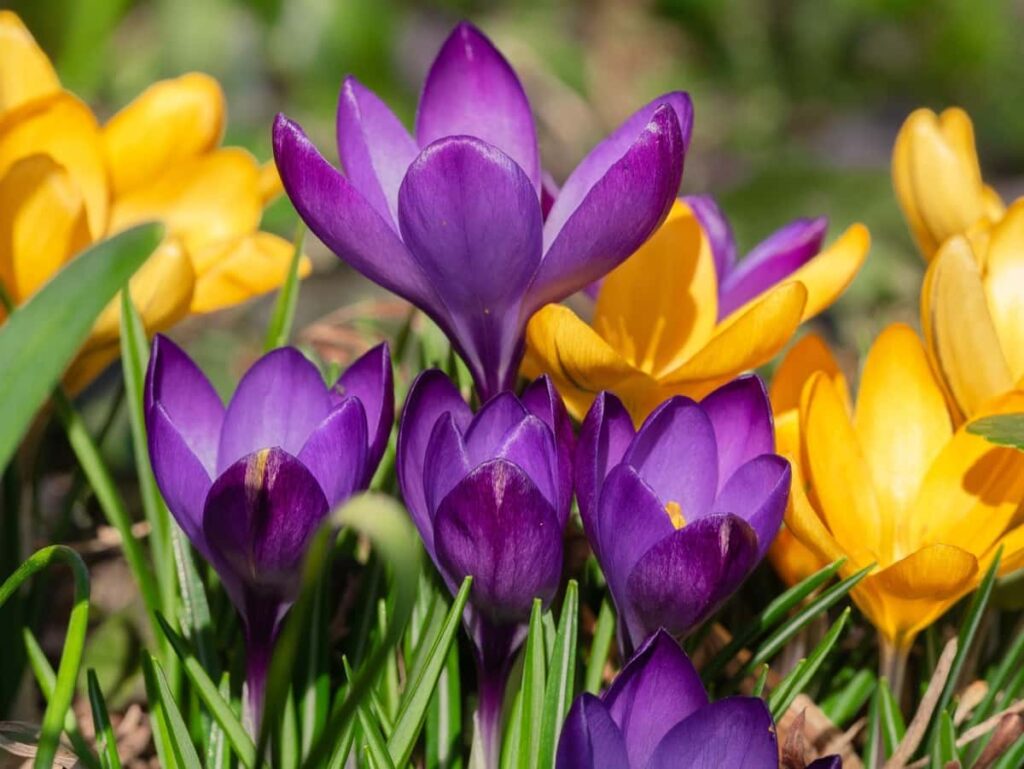
They live in various habitats, including meadows, scrubs, and woodlands. The majority of species grow between four and six inches tall. Cold to moderate winter conditions, such as those in climate zones 3 to 7, are ideal for crocuses. In hot climates, they will not grow. Due to their small size, crocuses dry out faster than large bulbs.
Primrose
There are at least 500 species in the Primula genus and an infinite number of hybrids and cultivars. Most are short-lived perennials. Generally, cultivated varieties have low rosettes of dark green foliage with umbrels of colorful flowers that emerge in spring on sturdy stalks. Primrose flowers are very diverse. Some primulas have clusters of flowers on a single stem, while others have one flower per each stem, with stems that skim the rosette of leaves between the flowers. These plants will bloom in late winter or early spring, based on where you live.
Winter Jasmine
Deciduous perennials like winter jasmines grow throughout the winter months. They are considered vines and belong to the olive family. While this type of jasmine is not fragrant, its stems remain green in winter, perhaps as a tradeoff. Native to China, winter jasmine plants are moderate growers.
When unsupported, winter jasmine plants reach 4 feet in height and 7 feet in width. They can reach a height of 15 feet when supported. Its plentiful yellow blooms are about 1 inch wide. Late winter is the best time to bloom. The flowers appear before the leaves, which are quite small.
Daphne
A daphne shrub makes a good foundation plant or specimen for a shrub border in a small yard. These evergreen shrubs have a sweet, fruity scent that makes them irresistible. Late winter to early spring brings delicate pink, white, or lavender blooms. In warm climates, daphnes produce white to light pink tubular flowers in spring or early winter, followed by small red berries. Slow-growing shrubs are usually planted from well-developed nursery plants in spring or early fall. When these plants reach maturity, they can reach relatively small sizes after seven to ten years.
Winter Aconite
Winter aconites are perennial herbaceous plants of the buttercup family native to temperate regions of Europe. Solitary flowers have five to eight yellow or white sepals (petals are reduced or absent) and multiple stamens. Their short stalks emerge from tuberous roots in early spring, often when snow is still on the ground. As the leaf stems are attached in the center of the leaf, they persist until mid-spring when the plant dies back.
Black tulips
Black tulips, also known as Queen of the Night tulips, are the perfect moody winter bloom. The velvety, deep maroon-black blooms on sturdy stems provide stunning contrast in borders and arrangements, making it the center of attention wherever it is displayed. Each glossy petal sparkles with a dark luster.
The selection is truly spectacular and should be tried at least once by every tulip enthusiast. Despite being associated with spring, tulips can be pretty resilient. In milder climates or if you feel up to the challenge, it’s worth planting these for late winter or early spring bloom.
Cyclamens
The Cyclamen plant has small, sweet-scented blooms on long stems stretching above the foliage. During its summer dormancy, it dies to its thick roots (tubers) before rapidly regrowing in the fall. The flowers come in shades of pink, purple, red, and white. Often with silver marbling, the heart-shaped leaves are medium green.
In case you missed it: Flowers Growing Season Chart in India: Sowing Guide, Germination, and Planting Calendar
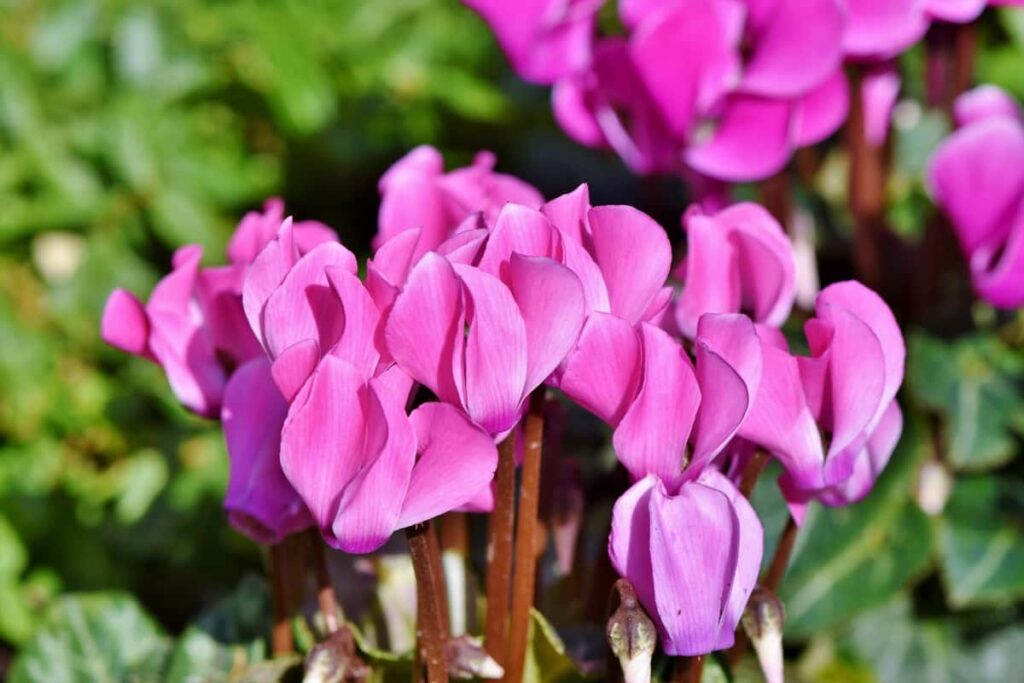
The cyclamen is commonly grown as a houseplant, and it’s especially popular during the winter holidays when you can find it blooming in garden centers and grocery stores. The seeds can be sown in late summer for blooms in the following year’s winter.
Clematis
Clematis has big, purple, star-shaped flowers on twining vines and is known as the “Queen of the Vines.”. It has showy flowers in the form of saucers, bells, tubes, open bells, doubles, and semidoubles. The flower shapes of autumn clematis range from large, eight-inch hybrids to dainty bells and honeysuckle blooms. Blooms produced by small-flowering varieties last longer than those produced by larger varieties. Purple, blue, pink, and white is the most common colors, though other colors are also available. It is possible to find scented clematis in a wide variety.
Lantana
In outdoor hanging baskets and as ground covers, lantana plants have a unique vine-like appearance from woody branches. Lantanas are known for their clusters of small, brightly colored flowers that may be yellow, orange, white, red, pink, blue, or purple. The almost fluorescent colors are often mixed within the same cluster, creating a bicolored appearance.
Its leaves resemble sandpaper. Although many dislikes this plant’s sharp, citrusy smell, the aroma of their foliage qualifies them as fragrant. This fast-growing plant can be planted at any time as a perennial or an annual.
Impatiens
Due to their brightly colored blooms and ability to grow in shady areas, impatiens plants are among the most popular bedding plants. Impatiens are often grown as annuals, where their blooming season ranges from spring to fall. There are various colors of impatiens flowers, including white, red, pink, violet, coral, purple, and yellow.
The vibrant colors of these blooms will create a beautiful aura wherever they are placed in your winter garden, making them a great addition to winter gardens. For the desired growth, it is necessary to provide proper water and fertilizer with well-drained soil.
Conclusion
When you choose plants suitable for your hardiness zone, you can grow a winter flower garden almost anywhere. In colder regions, some plants that bloom enthusiastically during mild winters may not do as well. Additionally, it is important to plant at the right time before the cold weather arrives; plant winter bloomers in the fall while the soil is still warm.
- Types of Pesticides Used in Agriculture: A Beginner’s Guide
- Economical Aquaculture: A Guide to Low-Budget Fish Farming
- 15 Common Planting Errors That Can Doom Your Fruit Trees
- How to Make Houseplants Bushy: Effective Tips and Ideas
- Innovative Strategies for Boosting Coconut Pollination and Yield
- Pollination Strategies for Maximum Pumpkin Yield
- The Complete Guide to Chicken Fattening: Strategies for Maximum Growth
- Natural Solutions for Tulip Problems: 100% Effective Remedies for Leaf and Bulb-Related Issues
- Revolutionizing Citrus Preservation: Towards a Healthier, Greener Future
- Natural Solutions for Peony Leaf and Flower Problems: 100% Effective Remedies
- Maximizing Profits with Avocado Contract Farming in India: A Comprehensive Guide
- Natural Solutions for Hydrangea Problems: 100% Effective Remedies for Leaf and Flowers
- The Ultimate Guide to Choosing the Perfect Foliage Friend: Bringing Life Indoors
- From Sunlight to Sustainability: 15 Ways to Use Solar Technology in Agriculture
- The Ultimate Guide to Dong Tao Chicken: Exploring from History to Raising
- The Eco-Friendly Makeover: How to Convert Your Unused Swimming Pool into a Fish Pond
- Mastering the Art of Delaware Chicken Farming: Essentials for Healthy Backyard Flocks
- 20 Best Homemade Fertilizers for Money Plant: DIY Recipes and Application Methods
- How to Craft a Comprehensive Free-Range Chicken Farming Business Plan
- Brighten Your Flock: Raising Easter Egger Chickens for Beauty and Bounty
- How to Optimize Your Poultry Egg Farm Business Plan with These Strategies
- Subsidy for Spirulina Cultivation: How Indian Government Schemes Encouraging Spirulina Farmers
- Ultimate Guide to Raising Dominique Chickens: Breeding, Feeding, Egg-Production, and Care
- Mastering the Art of Raising Jersey Giant Chickens: Care, Feeding, and More
- Ultimate Guide to Raising Legbar Chickens: Breeding, Farming Practices, Diet, Egg-Production
- How to Raise Welsummer Chickens: A Comprehensive Guide for Beginners
- How to Protect Indoor Plants in Winter: A Comprehensive Guide
- Ultimate Guide to Grow Bag Gardening: Tips, Tricks, and Planting Ideas for Urban Gardeners
- Guide to Lotus Cultivation: How to Propagate, Plant, Grow, Care, Cost, and Profit
- Agriculture Drone Subsidy Scheme: Government Kisan Subsidy, License, and How to Apply Online
- Ultimate Guide to Raising Araucana Chickens: Breed Profile, Farming Economics, Diet, and Care
- Bringing Hydroponics to Classroom: Importance, Benefits of Learning for School Students
- Ultimate Guide to Raising Polish Chickens: Breed Profile, Farming Economics, Diet, and Care
- Ultimate Guide to Raising Australorp Chickens: Profile, Farming Economics, Egg Production, Diet, and Care
- Silkie Chicken Farming: Raising Practices, Varieties, Egg Production, Diet, and Care
- Sussex Chicken Farming: Raising Practices, Varieties, Egg Production, Diet and Care